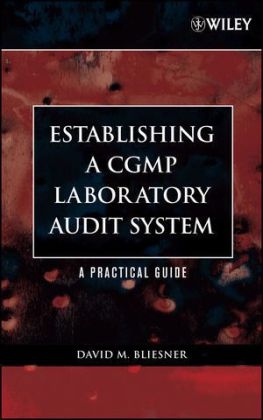
Establishing A CGMP Laboratory Audit System
Wiley-Interscience (Verlag)
978-0-471-73840-4 (ISBN)
- Lieferbar (Termin unbekannt)
- Versandkostenfrei
- Auch auf Rechnung
- Artikel merken
The first systematic, hands-on auditing guide for today's pharmaceutical laboratories
In today's litigious environment, pharmaceutical laboratories are subject to ever stricter operational guidelines as mandated by the FDA, and must be able to establish and demonstrate sustainable operational practices that ensure compliance with the current good manufacturing practice (CGMP) regulations. David Bliesner's Establishing a CGMP Laboratory Audit System: A Practical Guide is designed to provide laboratory supervisors and personnel with a step-by-step, hands-on audit system that they can rely on to ensure their facility remains compliant with all current and future requirements. Focusing on a "team approach," the author uses detailed flowcharts, checklists, and descriptions of the auditing process to help readers develop a new audit system or upgrade their current system in order to:
* Improve current compliance
* Demonstrate sustainable compliance
* Produce data for federal inspections
* Avoid regulatory action
Enhanced with detailed checklists and a wealth of practical and flexible auditing tools on CD-ROM, this book provides an ideal resource for new and future laboratory personnel, and an excellent means for keeping existing industry practitioners up to date on the nuances of operating a consistently compliant pharmaceutical laboratory.
DAVID M. BLIESNER, PhD, is the founder and President of Delphi Analytical Services, Inc., in Indian Rocks Beach, Florida, a company offering training, training technology, and compliance products and services to the pharmaceutical, biopharmaceutical, medical device, and contract analytical laboratory industries. Dr. Bliesner also conducts lectures, short courses, and hands-on training relating to technical aspects of the analytical laboratory and compliance with CGMPs and Good Laboratory Practices (GLPs).
Preface xiii
1 Introduction to the Quality Systems Approach to Cgmp Compliance 1
1.1 Overview of Quality Systems / 1
1.2 Quality Systems and Compliance with CGMPs: Reasons for Auditing Your Laboratory / 3
1.3 Goals of Auditing Your Laboratory / 3
1.4 Laboratory Audit Phases / 4
1.5 Integration with Existing Programs / 4
1.6 Modifiable and Scalable Approach / 4
Reference / 5
Bibliography / 5
2 Preparing for the Audit 6
2.1 Procedure / 6
2.2 Audit Tools and Templates / 6
2.2.1 Goals of the Audit / 14
2.2.2 Review of the Audit Process / 14
2.2.3 Laboratory Audit Form (LAF) Generation Process / 20
2.2.4 Subelement Audit Strategy Development / 20
3 Auditing and Data Capture 27
3.1 Additional Audit Preparation / 27
3.1.1 Data Capture and CGMP Deficiency Documentation / 27
3.1.2 Use of Random Statistical Sampling to Improve the Efficiency and Overall Audit Quality / 34
3.2 Procedure / 39
4 Organizing Data and Reporting the Results 45
4.1 Procedure / 45
4.2 Format and Content of the Audit Summary Report / 48
4.2.1 Header / 48
4.2.2 Background / 49
4.2.3 Approach / 49
4.2.4 Report Format / 49
4.2.5 Summary of Results / 50
4.2.6 Future Work / 51
4.2.7 Laboratory Controls Subelement Sections / 52
5 Developing and Implementing a Corrective Action Plan 53
5.1 Procedure / 53
5.2 LAF-to-CAPA Workflow Diagram: Converting Example Audit Findings to Example Corrective and Preventive Actions / 66
5.2.1 Step 1 Audit Finding Notebook Entries / 66
5.2.2 Step 2 Formal Documentation of Finding or Deficiency on LAFs / 66
5.2.3 Step 3 Common Root-Cause Correlation by Management / 67
5.2.4 Step 4 LAF Linkage to System Deficiencies / 67
5.2.5 Step 5 Management Assignment of Corrective Actions to Address System Deficiency / 67
5.2.6 Step 6 Work Breakdown Structure (WBS) Is Generated / 68
5.2.7 Step 7 Corrective Action Project Plan (CAPP) Created From WBS and Executed / 68
5.2.8 Step 8 Corrective and Preventive Actions (CAPAs) for System Deficiencies / 68
6 Developing and Implementing a Verification Plan 69
6.1 Procedure / 69
6.2 Corrective Action Verification Process / 69
6.2.1 Step 1 Action Owners Work with Corrective Action Team to Design and Implement Systems-Based Corrective Actions / 75
6.2.2 Step 2 Corrective and Preventive Actions Are Implemented / 77
6.2.3 Step 3 In-Use Data for Implemented Corrective and Preventive Actions Are Generated / 77
6.2.4 Step 4 Action Owners Working with Corrective Action Team Create Preverification Packages for Verifiers / 77
6.2.5 Step 5 Verification Team Leader Schedules Verification with Verifiers, Action Owners, and Functional Area Managers / 77
6.2.6 Step 6 Verifiers Review Preverification Packages / 78
6.2.7 Step 7 Verifiers Generate Verification Plans / 78
6.2.8 Step 8 Verifiers Meet with Action Owners as Scheduled by Corrective Action Team Leader / 78
6.2.9 Step 9 Verifiers Begin Verifying Corrective and Preventive Actions in the Functional Area / 78
6.2.10 Step 10 Verifiers Determine Whether Action Is Verifiable or Not Verifiable / 78
6.2.11 Step 11 Verifiers Create Verification Report / 79
6.2.12 Step 12 Verification Team Leader Schedules Verifiers to Present Findings Before the Verification Review Board / 82
6.2.13 Step 13 Verifier Forwards Verification Report to Verification Review Board for Review / 82
6.2.14 Step 14 Verifier Presents Report to Verification Review Board / 82
6.2.15 Step 15 Verification Board Determines if the Action Is (1) Verifiable, (2) Not Verifiable or, (3) Verifiable Pending In-Use Data / 82
6.2.16 Step 16 Verifier Modifies or Corrects Verification Report as Necessary on Verifiable Actions / 82
6.2.17 Step 17 Verifiable Actions are Closed by Action Owner, Corrective Action Team Leader, and Verification Team Leader / 83
6.2.18 Step 18 Nonverifiable Actions Are Sent Back to Action Owner for Additional Work / 83
6.2.19 Step 19 Verifiers Reverify Uncompleted Actions When Scheduled by Verification Team Leader / 83
7 Developing and Implementing a Monitoring Plan 84
7.1 Procedure / 84
8 A Summary for Establishing a Cgmp Laboratory Audit System 89
8.1 A Brief Review of the Guide / 89
8.2 Additional Lessons for the End User / 90
8.2.1 A Proven Approach / 90
8.2.2 Applicability to Your Facility / 90
8.2.3 The Value of Systems-Based Solutions / 91
8.2.4 No Immunity: Every Laboratory Is a Potential Compliance Accident in the Making / 92
8.2.5 Audits as Learning Tools / 92
8.2.6 The Linkage Between Ownership and Success / 92
8.2.7 Compliance Is Good Business / 93
Appendix I Example Audit Checklists: Laboratory Subelements 94
Appendix II Example Template for An Audit Summary Report 146
Appendix III Glossary of Cgmp and Audit System Terms 200
Appendix IV Fda Compliance Program Guidance Manual 7356.002 "drug Manufacturing Inspections" 215
Appendix v 21 Code of U.s. Federal Regulations Parts 210 and 211 Current Good Manufacturing Practice Regulations 236
Index 269
| Erscheint lt. Verlag | 23.5.2006 |
|---|---|
| Zusatzinfo | Charts: 17 B&W, 0 Color; Screen captures: 1 B&W, 0 Color; Tables: 33 B&W, 0 Color |
| Sprache | englisch |
| Maße | 160 x 241 mm |
| Gewicht | 558 g |
| Einbandart | gebunden |
| Themenwelt | Naturwissenschaften ► Chemie |
| ISBN-10 | 0-471-73840-9 / 0471738409 |
| ISBN-13 | 978-0-471-73840-4 / 9780471738404 |
| Zustand | Neuware |
| Haben Sie eine Frage zum Produkt? |
aus dem Bereich


